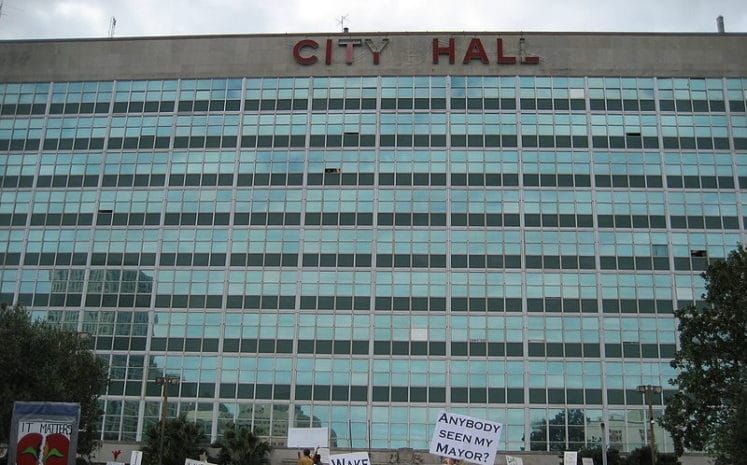In the policy world, regulatory capture is a term that is used to describe the phenomenon of regulators becoming tools of the industries that they are supposed to regulate, instead of serving the public interest.
But for the New Orleans City Council, some have suggested that the term should be regulatory surrender. Clean energy advocates argue that the body which is tasked with regulating Entergy New Orleans (ENO) has in many cases served as a rubber stamp for the utility’s decisions, which is typically done under the advice of highly paid consultants whose independence has been questioned.
That is, until this summer. In the wake of the scandal of ENO paying actors through a subcontractor to boo solar and fake public support for a gas plant, the New Orleans City Council has pushed the utility to actually move forward with building and procuring the large-scale solar projects that it has been talking about for more than two years.
ENO first announced plants to issue a 20 MW request for proposals for renewable energy in March 2016. In testimony given this past July Seth Cureington, the company’s director of resource planning and market operations, made various excuses as to why ENO never actually procured any renewable energy capacity under this program, despite the capacity ballooning to 100 MW.
But there may be a simple answer to why ENO never acted: the New Orleans City Council never required the utility to do so. This is despite clear and obvious economic benefits to a city whose electricity use spikes during summer days due to widespread air conditioning use.
But that was before the New Orleans City Council and ENO attracted national media attention for the company’s use of paid actors fake public support for the 128 MW gas plant that ENO seeks to build in New Orleans East.
In the wake of this scandal the Council has made no moves to rescind its approval of the gas plant, and told pv magazine that it is waiting on the results of an investigation. However since that time ENO CEO Charles Rice resigned, to be replaced on an interim basis with former CEO Rod West. And the City Council’s Utility, Cable, Telecommunications and Technologies Committee has asked ENO to actually file its application to build and procure 90 MW of large-scale solar, which the utility did on July 31.
The plan calls for three projects:
- 50 MW plant to be built and owned by a third-party developer in Washington Parish, from which ENO will buy power
- 20 MW plant to be built by a third party under a build-own-transfer agreement in St. James Parish
- 20 MW plant which Entergy will build, own and operate in New Orleans East
As ENO’s peak load is around 1 GW, the capacity of these plants would be equivalent to around 9% of peak demand. When another 40 MW of small-scale (mostly rooftop) solar in New Orleans is added, solar could meet as much as 13% of peak. This is far less than California, but not an insignificant amount for the U.S. South.
Local ratepayer and clean energy advocacy organization Alliance for Affordable Energy (AEE) states that it expects approval for these projects in December. And while exact prices were not publicly available, AEE further has expressed concerns about the cost of the project in New Orleans East, which will be on land leased from NASA near its Michoud facility.
Other documents filed by Entergy have indicated that it expects the 50 MW project in Washington Parish to come online in 2021. These would be the first solar projects in Louisiana larger than a few megawatts that pv magazine has heard of, and according to statistics by SEIA would double the current installed capacity in the state, which is almost entirely comprised of residential installations.
On July 31 ENO also filed its rate case. As if further demonstration of the audacity of the utility and its confidence that it could bilk New Orleans residents without consequence was needed, ENO asked to increase fixed charges to $24 per month on its customers, as well as a 10.75% return on equity.
This is one of the highest fixed charges pv magazine has seen proposed, and would doubtlessly have impacted the economics of rooftop solar, as well as hitting low-income residents, while returning an unheard-of profit margin to the utility.
However, the utilities committee, which is chaired by council VP Helena Moreno (D), has rejected ENO’s rate plan. The significance of the national and local media attention directed towards both the utility and the council is likely not lost on Moreno, who is a former television anchor.
It remains to be seen what will happen with both ENO and the Council’s Utilities Committee after the cameras stop rolling and the national media attention moves on.
Editor’s note: the author is a former employee of the Alliance for Affordable Energy
This content is protected by copyright and may not be reused. If you want to cooperate with us and would like to reuse some of our content, please contact: editors@pv-magazine.com.









By submitting this form you agree to pv magazine using your data for the purposes of publishing your comment.
Your personal data will only be disclosed or otherwise transmitted to third parties for the purposes of spam filtering or if this is necessary for technical maintenance of the website. Any other transfer to third parties will not take place unless this is justified on the basis of applicable data protection regulations or if pv magazine is legally obliged to do so.
You may revoke this consent at any time with effect for the future, in which case your personal data will be deleted immediately. Otherwise, your data will be deleted if pv magazine has processed your request or the purpose of data storage is fulfilled.
Further information on data privacy can be found in our Data Protection Policy.